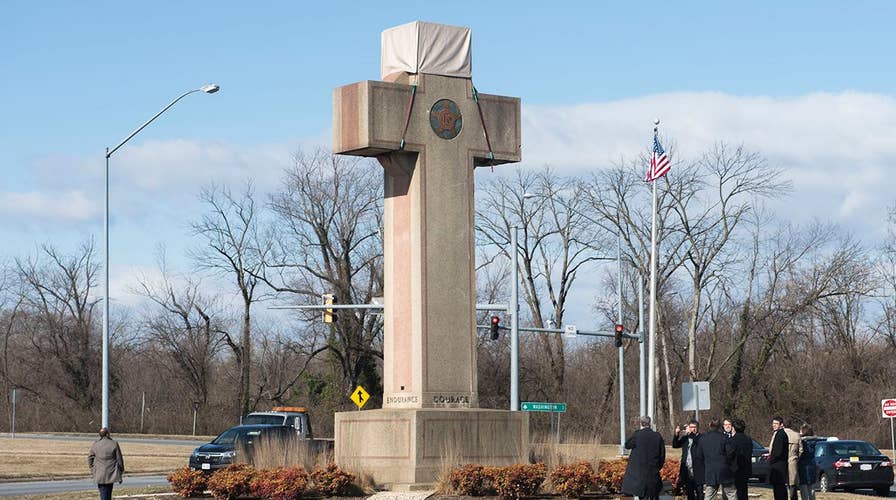Veterans fight to keep WWI 'Peace Cross' memorial on public land
Supreme Court debates war memorial; 'Fox News @ Night' host Shannon Bream has the details.
Americans are baffled, frustrated, and confused over court decisions concerning the place of religion in public life.
Teachers fear allowing candy canes in the classroom at Christmas, lest they lead to legal liability. Transit authorities refuse to allow a church to purchase ad space on city buses at Christmas if the ad features shepherds, sheep, and stars.
Others seize upon the confusion to clear the countryside of anything looking religious. Veterans’ memorials are common targets. Crosses have often been used to remember America’s war dead. Whether marking an actual grave, like those in Flanders’ famous field or on a hill in the middle of the Mojave Desert, cross-shaped Veterans memorials are symbols of service and sacrifice.
‘PEACE CROSS’ MEMORIAL AT CENTER OF LANDMARK SUPREME COURT FIGHT OVER RELIGIOUS DISPLAYS
Activists think they violate the constitution. That includes the Bladensburg WWI Veterans Memorial—a memorial outside Washington, D.C. shaped like a Celtic cross. The American Legion erected it in 1925 to the memory of 49 men from Prince George’s County, Maryland, who died in the Great War. Locals look on the memorial with pride and affection, calling it the "Peace Cross." Humanists want the memorial moved, disfigured, or destroyed.
While the Justices heard argument inside the court last month in The American Legion v. American Humanist Association, activists railed against the Peace Cross outside. One declared that the Peace Cross essentially gives some veterans the "middle finger" and is a "gang symbol" of Christianity.
For some reason, a passive cross-shaped veterans memorial offends them. But our constitution guarantees the right to be free of government coercion, not the right to avoid religious images altogether.
Meanwhile, the legal argument inside the Court has left pundits everywhere predicting what’s next. Much of the analysis seeks to prop up what lawyers call "the Lemon test."
Named for the 1971 case of Lemon v. Kurtzman, the Lemon test asks a number of subjective questions gauging the purpose, effect, and potential endorsement of religion of a particular state action, very often memorials and monuments. The Lemon test has led to embarrassing and absurd results, including the need for local officials to make sure they have enough reindeer near a city’s nativity display in order to make it secular enough.
Justice Neil Gorsuch was right when he suggested at argument that it may be time "to thank Lemon for its services and send it on its way." After all, for most of the republic’s history, we did not have—or need—Lemon. The Establishment Clause by itself worked just fine.
Everyone agrees that the Lemon test is a cumbersome standard. Activists take advantage of the clumsy test to further purge the public square of religious images.
The purpose of the Establishment Clause for the majority of our republic’s history has been to prevent the government from coercing the religious belief or behavior of its citizens, not purge religious symbols from the public square. Passive memorials, like the Bladensburg WWI Veterans Memorial, do nothing to coerce anyone to do or believe anything. The Peace Cross merely stands in witness of the service and sacrifice of 49 men who died defending freedom.
Activists targeting for destruction memorials like the Peace Cross, and free standing cross-shaped memorials just like it in nearby Arlington National Cemetery, base their lawsuits on offense. That is no basis for a lawsuit. As Justice Gorsuch noted from the bench, "We accept that people have to sometimes live in a world in which other people's speech offend them. We have to tolerate one another."
And yet, activists insist that their offense be assuaged at the cost of tearing down a memorial that one mother called her son’s "gravestone."
Rather than restrain government, the four decades of case law since Lemon v. Kurtzman interpreting the Establishment Clause has unleashed a hostility toward religion that would shock the First Amendment’s authors. Because of Lemon and the confusing, court-created tests since, confused local officials ban religion just to be safe.
That is why we proposed an alternative: that the Supreme Court abandon Lemon and adopt an alternative test, one more historically-grounded that protects religious liberty by preventing the compulsion and suppression of religious exercise. Under this approach, the Court would rightly restore the delicate balance between restraining government and setting citizens free to exercise their religion.
CLICK HERE TO GET THE FOX NEWS APP
Such a clarification by the Court would end the repeated attempts to unleash bulldozers and sandblasters against religious text and images in public places across the country.
The Founding Fathers never meant for the Establishment Clause to unleash a religious cleansing upon the country. Our hope is that the Justices of the U.S. Supreme Court will put an end to these seek-and-destroy missions, restoring the Establishment Clause to its rightful place.


